How often should you train your Glutes?
What you’re getting yourself into:
~5000 words
15-20 minute read time
Key Points
1. Muscle SRA (Stimulus, Recovery and Adaptation) is the primary underlying principle that dictates how often you should train the Glutes to grow them as fast as humanly possible.
2. Muscle protein synthesis increases during Recovery and Adaptation. According to science, muscle protein synthesis stays elevated for up to 4 days (Damas et al., 2016; Miller et al., 2005). How many days exactly depends on multiple factors.
3. Exercise type, one of these factors, influences the time it takes for the Glute SRA process to be completed. Which in turn determines the best time to work them again.
4. Exercises have 4 aspects to them that influence recovery/adaptation time: (1) muscle activity, (2) range of motion, (3) emphasis on eccentrics, and (4) muscle length at peak tension. Based on these aspects, the following Glute exercise types can be identified: Stretchers, Activators, and Pumpers.
5. Glute exercise type dictates how often you should train the glutes, and how to design your training program.
The best training frequency for muscle growth is a controversial topic. Most elite bodybuilders swear by training a muscle only once a week (Hackett et al., 2013). A recent meta-analysis concluded that working a muscle group twice per week was superior for hypertrophy compared to once per week (Schoenfeld et al., 2016). Still, modern progressive lifters argue that training a muscle multiple times per week gives better results. Bret’s client Erin is a perfect example of this. She’s seen amazing results training the Glutes a whopping 6 times per week! How often should you train the glutes for maximum results? The short answer is 2-6 times per week. The long answer requires you to read on, as there are variables you will need to adjust in order to optimize your recovery and ability to train effectively at a given frequency.
On StrengthandConditioningResearch.com, an encyclopedia of science-based information, Chris Beardsley states:
“training with a specific volume-matched frequency might be more effective than another volume-matched frequency because the distribution of the hypertrophic stimuli over the course of a training week are optimal in one case and not in the other.”
Basically, it’s saying that spreading out 15 sets for a muscle over several workouts during the week might grow more muscle than doing all 15 sets in one go. Some well-respected experts in the field hypothesize there’s indeed a maximum growth stimulus a muscle can get per workout (Dankel et al., 2016). Say for example the maximum growth stimulus would happen at 6 sets. Any sets beyond that point could be regarded as ‘wasted sets’.
Going from this logic, with a traditional ‘bodybuilding’ split (frequency of training a muscle 1x per week) a lot of these 15 sets would be wasted. Full body routines typically spread the 15 sets out over several days. This may results in less wasted sets per workout. ‘Wasted’ might not be the best wording for these sets. They could even be labeled as counterproductive, as the extra sets might hamper your recovery from the growth stimulus! More on that later.
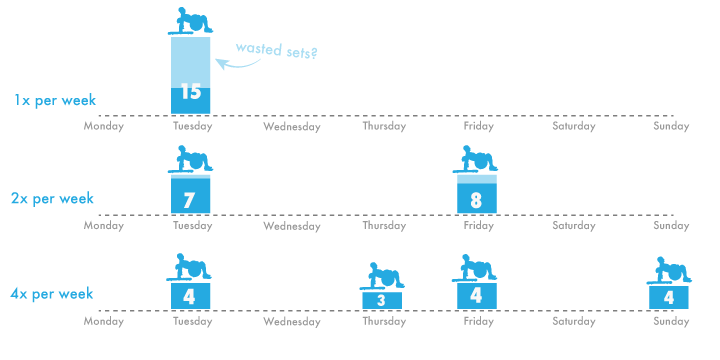 If indeed it’s more optimal to train a muscle multiple times per week, over how many days should these 15 sets be spread? 2? 3? 4? 5? 6 days?
If indeed it’s more optimal to train a muscle multiple times per week, over how many days should these 15 sets be spread? 2? 3? 4? 5? 6 days?
According to science, it depends on multiple factors. In this article, I’m going to primarily talk about one of those factors: Exercise Type. By the end of this article, you will understand how exercise type influences how often you should train the Glutes. I will end by giving some practical advice on how to apply this knowledge to your training.
First, we have to understand the primary underlying concept that dictates the relationship between Exercise Type and training frequency: muscle SRA.
The muscle SRA curve
The S in muscle SRA is for Stimulus. During a training session you break down the muscle, the Stimulus for growth. Because of this, the muscle’s functional size – the part of the muscle that’s still able to contract – decreases. The body will then rebuild the broken down muscle. This is called Recovery, the R in SRA. After the body is done rebuilding, it prevents future breakdown of the muscle from happening. It does this by building the muscle bigger than before. This is called Adaptation, the A in SRA. The muscle is now more resistant to a future Stimulus (a thicker wall needs a bigger sledgehammer to break it down). The following image illustrates this process.
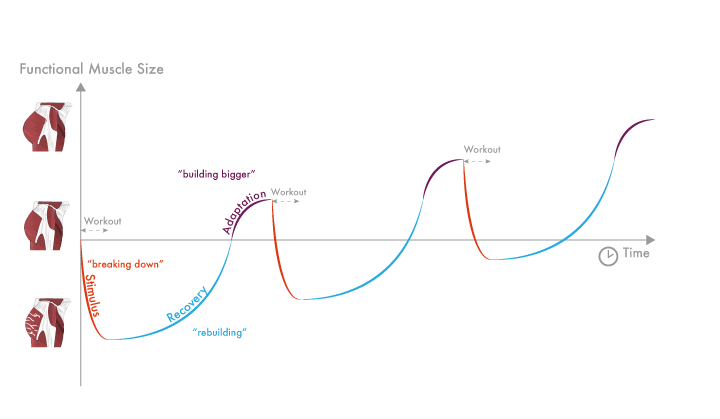 However, if this sledgehammer is too big, it can cause trouble in the recovery/adaptation process. I briefly talked about this in the introduction: doing too many sets per workout might not only be a waste of effort, it might even hamper your overall muscle growth (Dankel et al., 2016). The image below shows how too big of a stimulus can potentially deform the SRA curve, removing the adaptation part.
However, if this sledgehammer is too big, it can cause trouble in the recovery/adaptation process. I briefly talked about this in the introduction: doing too many sets per workout might not only be a waste of effort, it might even hamper your overall muscle growth (Dankel et al., 2016). The image below shows how too big of a stimulus can potentially deform the SRA curve, removing the adaptation part. Finally, the SRA principle doesn’t exclusively apply to muscle. For example, the nervous system and connective tissues (such as muscle tendons), also have SRA curves. However, that’s beyond the scope of this article. Here, I will focus on muscle SRA.
Finally, the SRA principle doesn’t exclusively apply to muscle. For example, the nervous system and connective tissues (such as muscle tendons), also have SRA curves. However, that’s beyond the scope of this article. Here, I will focus on muscle SRA.Muscle Protein Synthesis
In scientific terms, the rebuilding (recovery) and ‘building bigger’ (adaptation) of the muscle happens through muscle protein synthesis (article by Trommelen, 2016; Damas et al., 2016). During the course of the muscle SRA curve, muscle protein synthesis is constantly elevated (Brook et al., 2015; Damas et al., 2016; Franchi et al., 2015). When it gets back down to baseline, recovery and adaptation are completed. That is the perfect time to stimulate the muscle again to restart the muscle SRA curve. This is illustrated in the image below.
 When should you train again?
When should you train again?
Muscle SRA partly answers this question: when the muscle SRA curve is completed.
Train too frequently, and the muscle will actually decrease in functional size over time, because you constantly stimulate before the muscle has completed recovery and adaptation. Train too infrequently, and you are unable to use the peak of the SRA curve as a new starting point for further muscle growth. You can see both situations in the image below.
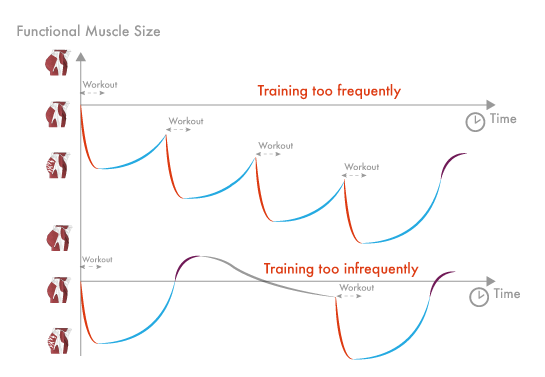 So, ideally you want to train again as soon as recovery and adaptation of the muscle is completed. This will grow them as fast as possible.
So, ideally you want to train again as soon as recovery and adaptation of the muscle is completed. This will grow them as fast as possible.
 How long does the Glute SRA curve take to complete?
How long does the Glute SRA curve take to complete?
With a new technique to measure long-term muscle protein synthesis, researchers have shown that muscle protein synthesis can remain elevated for a maximum of 72 to 96 hours (3 to 4 days) (Damas et al., 2016; Miller et al., 2005). As we now know, muscle protein synthesis underlies the rebuilding (recovery) and building bigger (adaptation) of muscles.
Now let’s focus on the muscle group of our interest: the Glutes. It takes a maximum of 72 to 96 hours (3 to 4 days) to complete a muscle SRA curve. That means waiting for 120 to 144 hours (5 to 6 days) between Glute workouts wouldn’t make sense if you want them to grow as fast as possible!
But how long should you wait? 1 day? 2 days? 3.36 days? Well, it depends. According to science, the following factors are important:
- Type of Glute Exercise
- Glute Training Experience
Now let’s talk about the first of those factors: Type of Glute Exercise. In a later article, I will cover Glute Training Experience.
Type of Exercise and muscle SRA: 4 aspects
Particularly for the Glutes, you can choose from an impressive collection of exercises: external rotations, hip thrusts, hip abductions, squats, lunges, step-ups, deadlifts, and all of their variations; each of them stimulate the Glutes.
However, some exercises have longer muscle SRA curves than others. Imagine this: You’re doing 4 sets of Band Side Walks on Tuesday, and 4 sets of heavy Bulgarian Split Squats on Friday. Do the Glutes take equal time to Recover and Adapt from these 2 training sessions? Heck no! Muscle recovery and adaptation from the heavy Bulgarian Split Squats takes much longer.
But.. Why? There are 4 well-documented aspects of an exercise that influence the length of the muscle SRA curve.
1. Muscle activity
Muscle activity during an exercise is closely linked to producing muscle tension (Alkner et al.,2000; Miller, 2014). Muscle tension is important in Stimulating a muscle to grow (Schoenfeld, 2010). If you don’t believe me, try growing your Glutes by doing biceps curls (which show close to zero Glute activity).
As we know, a muscle grows by recovering and adapting to a stimulus. Low muscle activation equals low muscle tension, which leads to a small stimulus that has a short recovery time. High muscle activation equals high muscle tension, which leads to a bigger stimulus that has a longer recovery and adaptation time. The following image illustrates a study that’s demonstrated this (Soares et al., 2015). Bret has studied the activity of the biceps during both of these exercises in the past.
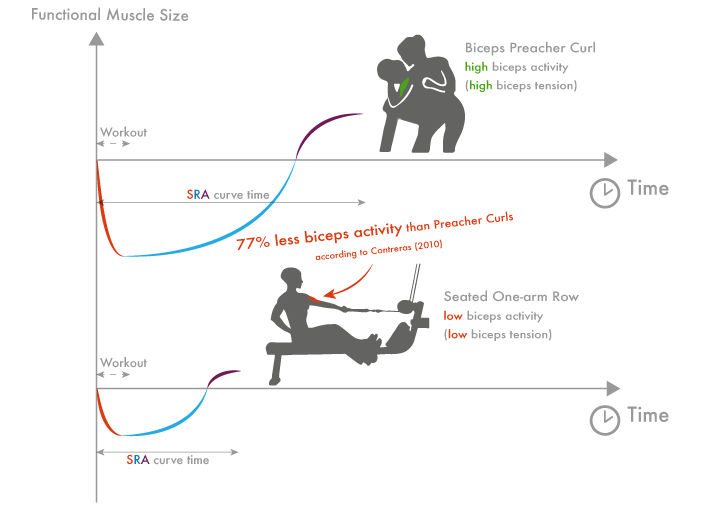 2. Range of motion
2. Range of motion
When an exercise brings a muscle through a bigger Range of Motion (ROM), the muscle does more work (muscular work = muscle force/tension x excursion/distance). This muscular work is often incorrectly called ‘training volume’ (read my article on calculating training volume to see why).
As we would expect, studies show that the more heavy work (training volume) a muscle performs, the longer recovery takes (Lieber & Fridén, 1993; Nosaka et al., 2002; Nosaka et al., 2003). This indicates that exercises with a bigger ROM take the muscle longer to recover (and adapt) from, probably because there’s more muscle breakdown due to increased heavy muscle work.
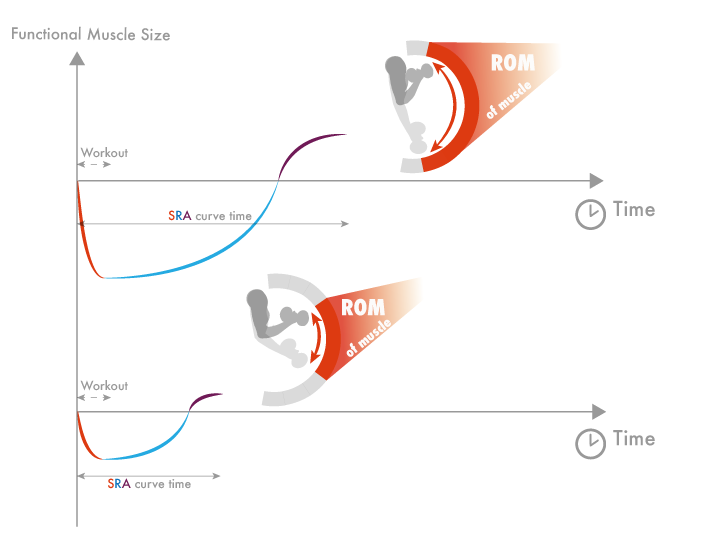 An example of a Glute exercise with a big ROM would be a Lunge or Bulgarian Split Squat. A Band Side Walk, however, has a small ROM, and takes shorter time to recover and adapt from.
An example of a Glute exercise with a big ROM would be a Lunge or Bulgarian Split Squat. A Band Side Walk, however, has a small ROM, and takes shorter time to recover and adapt from.3. Emphasis on eccentrics
Early research shows that heavy eccentrics break down the muscle more than heavy concentric movements (Clarkson et al., 1986; Gibala et al., 1995; Gibala et al., 2000; Nosaka et al., 2002).
As expected, the participants from these studies also took much longer to recover to their old performance levels after the eccentrics. However, they took only 1 day to recover from the concentric movements. The following image illustrates this in terms of muscle SRA.
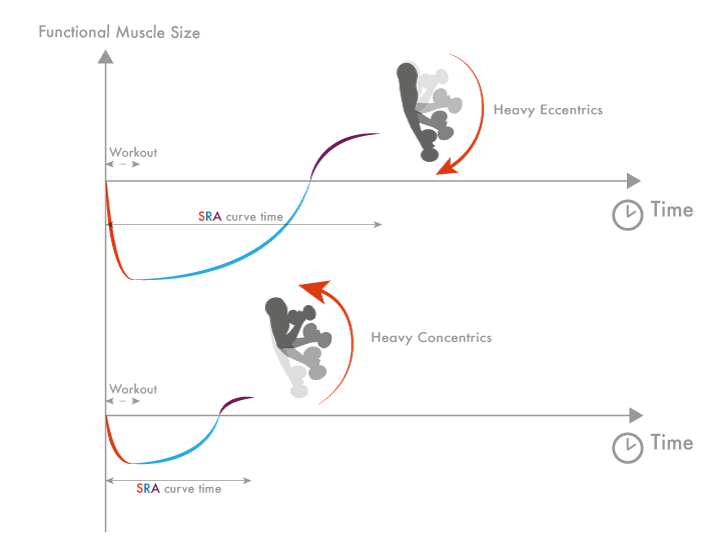 An example of a Glute exercise with an emphasis on eccentrics would be the Full Squat. You really have to control the weight while going down, while tension on the Glutes gets greater and greater. On the other hand, Band Hip Thrusts are only heavy at the top, and increasingly lighter when going to the bottom (because the elastic resistance decreases). It’s clear that Full Squats emphasize the eccentric part of the movement, and Band Hip Thrusts don’t. Because of this, Squats probably take longer to recover and adapt from.
An example of a Glute exercise with an emphasis on eccentrics would be the Full Squat. You really have to control the weight while going down, while tension on the Glutes gets greater and greater. On the other hand, Band Hip Thrusts are only heavy at the top, and increasingly lighter when going to the bottom (because the elastic resistance decreases). It’s clear that Full Squats emphasize the eccentric part of the movement, and Band Hip Thrusts don’t. Because of this, Squats probably take longer to recover and adapt from.4. Muscle length at peak tension
More recent studies also show that firing muscles hard when they’re lengthened causes more muscle breakdown compared to when they’re shortened. As expected, these exercises also took longer to recover and adapt from (McHugh & Pasiakos, 2004; Nosaka et al., 2005; Soares et al., 2015).
The image below shows two versions of the partial Biceps Curl. If you only do the bottom portion of the exercise (top of image), there is peak tension in the biceps when it’s lengthened. This results in more muscle breakdown, and a longer SRA curve. If you do only do the top portion (bottom of image) there is peak tension when it’s shortened, resulting in less muscle breakdown, and a shorter SRA curve.
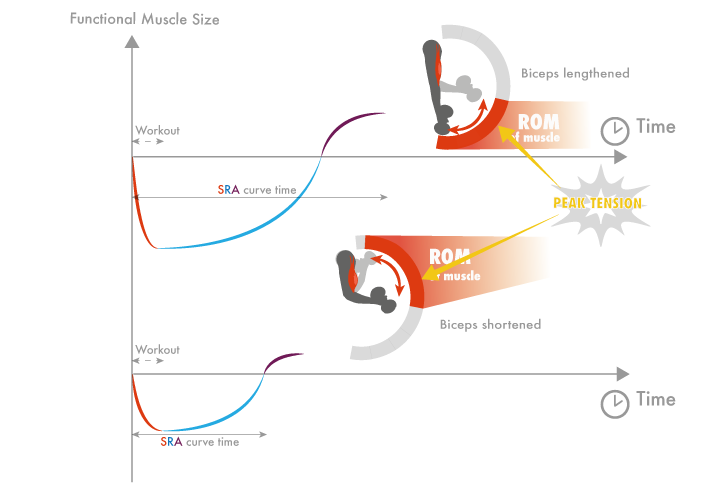 To further clarify how this works for Glute exercises, consider the Parallel Squat and the Barbell Hip Thrust. For the Squat, peak tension happens at the bottom, when the Glutes are lengthened. For the Barbell Hip Thrust, peak tension happens at the top, when the Glutes are maximally shortened. The image below illustrates this.
To further clarify how this works for Glute exercises, consider the Parallel Squat and the Barbell Hip Thrust. For the Squat, peak tension happens at the bottom, when the Glutes are lengthened. For the Barbell Hip Thrust, peak tension happens at the top, when the Glutes are maximally shortened. The image below illustrates this.
 Back to the Glutes
Back to the Glutes
Now let’s apply these 4 aspects to some Glute exercises…
Full Squats take long to recover from, because they show moderate Glute activity (1), bring the Glutes through a big ROM (2), with an emphasis on the eccentric phase (3) and there’s peak tension when the Glutes are lengthened (4). Combine these, and you have a lot of muscle breakdown, which needs more time to recover (and adapt) from. Hence, the SRA curve takes the longest time to complete (3-4 days). We could categorize the Full Squat as a Stretcher type of exercise.
Barbell Hip Thrusts take less time to recover from, because the ROM is smaller (2), and there’s peak tension when the Glutes are maximally shortened (4). However, the Barbell Hip Thrust shows tremendous Glute activity (1) (Contreras et al., 2015) with a heavy-loaded eccentric phase (if you control the weight down, which a lot of people don’t do) (3). High muscle tension particularly stimulates the ‘building bigger’ (adaptation) part of the SRA curve (Schoenfeld, 2010). As a result, the SRA curve takes moderately long to complete (2-3 days). We could label it as an Activator type of exercise.
Finally, Band Side Walks have a very small ROM (2). The average Glute activity is low (1). They show peak tension when the muscle is shortened (4). Hence, the SRA curve probably takes a short while to complete (1-2 days). We could categorize it as a Pumper type of exercise. That’s because the short range of motion and varying tension on the Glutes (band elastic resistance changes) allow for more reps to be performed, which causes a lot of “metabolic stress” (more on this later).
The categories of exercises, their related aspects, and estimated SRA completion times are summarized below.
 There are some experts, such as Stuart Phillips, who think that categorization between muscle damage, muscle tension, and metabolic stress (the basis for the categorization below) is overrated. He and others hypothesize that they all come down to one underlying factor: motor unit recruitment (Burd et al., 2012). Still, I stick to Brad Schoenfeld’s notion of damage, tension, and metabolic stress to categorize the Glute exercises below, as there’s a logical framework of scientific evidence supporting it (Schoenfeld, 2010). Also, for every exercise, you can see which part of the Glutes it emphasizes. Don’t take this as a black/white distinction, but more as a grey area where upper and lower Glute activation overlap.
There are some experts, such as Stuart Phillips, who think that categorization between muscle damage, muscle tension, and metabolic stress (the basis for the categorization below) is overrated. He and others hypothesize that they all come down to one underlying factor: motor unit recruitment (Burd et al., 2012). Still, I stick to Brad Schoenfeld’s notion of damage, tension, and metabolic stress to categorize the Glute exercises below, as there’s a logical framework of scientific evidence supporting it (Schoenfeld, 2010). Also, for every exercise, you can see which part of the Glutes it emphasizes. Don’t take this as a black/white distinction, but more as a grey area where upper and lower Glute activation overlap.
 Pumpers, metabolic stress and SRA
Pumpers, metabolic stress and SRA
High-rep sets of pumpers often lead to a muscle pump due to the occlusion of veins via constant tension on the muscles and a serious burning sensation in the muscle due to a build-up of certain metabolites (Schoenfeld & Contreras, 2014). This is also called metabolic stress, one of the 3 proposed drivers of muscle growth, along with muscle tension and muscle breakdown (Schoenfeld, 2013). Sadly, we don’t know much about how long muscle protein synthesis stays elevated after doing metabolically stressful exercise (Schoenfeld, 2010; Schoenfeld, 2013). However, muscle recovery and adaptation from pumpers, which are related to muscle protein synthesis, probably takes between 1 to 2 days. That’s because multiple studies show strength is back to baseline within this time (Loenneke et al., 2013; Thiebaud et al., 2013). Anecdotally we can confirm this. 5 sets of heavy Deadlifts can leave you smashed for multiple days after. This simply isn’t the case with Frog Pumps.
Some further anecdotal evidence…
Remember how I mentioned Bret’s client Erin at the introduction of this article? She’s a great example of someone who perfectly matched exercise type with recovery/adaptation time.
After some time as Bret’s guinea pig in the Glute Lab, Erin discovered that she responded a lot better to pumper-type of exercises, such as the Band Side Walk and the Band Deadlift. During the next couple of months, she was doing pumpers 6 days a week. The results were incredible! In terms of SRA, the following probably happened:
 For Erin, the high workout frequency was just what she needed to take her Glutes to the next level. However, the key point here is that she did pumpers to achieve this. If she had chosen to do stretchers, her muscle size progress might have looked something like this…
For Erin, the high workout frequency was just what she needed to take her Glutes to the next level. However, the key point here is that she did pumpers to achieve this. If she had chosen to do stretchers, her muscle size progress might have looked something like this… Sure, her muscle protein synthesis would get elevated all this time (at first). But her Glutes would be shrinking (maybe they wouldn’t shrink but they certainly wouldn’t be growing), because she wouldn’t allow proper time to pass before training them again. As a result of the decrease in Glute size, she would also get weaker and weaker every workout. At some point, she wouldn’t be able to have an overloading workout anymore. No overload, no stimulus, no elevated muscle protein synthesis. Stretchers take more time to recover from than pumpers because they create more strain and damage. Damage and soreness is good up until a point, but it can quickly become counterproductive (Schoenfeld & Contreras, 2013), so you need to keep stretcher volume in check and make sure to include ample pumper volume in your program.
Sure, her muscle protein synthesis would get elevated all this time (at first). But her Glutes would be shrinking (maybe they wouldn’t shrink but they certainly wouldn’t be growing), because she wouldn’t allow proper time to pass before training them again. As a result of the decrease in Glute size, she would also get weaker and weaker every workout. At some point, she wouldn’t be able to have an overloading workout anymore. No overload, no stimulus, no elevated muscle protein synthesis. Stretchers take more time to recover from than pumpers because they create more strain and damage. Damage and soreness is good up until a point, but it can quickly become counterproductive (Schoenfeld & Contreras, 2013), so you need to keep stretcher volume in check and make sure to include ample pumper volume in your program.Pro tip: turning Stretchers/Activators into Pumpers
Some of the Stretcher and Activator type exercises can be turned into Pumpers. How? Well, let’s take the Full Squat as an example. The squat loads the Glutes the most at the bottom part.
You can further increase the Glutes’ activity (1) by putting an elastic band around your knees. In order to keep the tension on the Glutes, and to shorten the Range of Motion (2), you want to bounce up and down out of the hole of the squat while only coming half to two-thirds the way up, thereby keeping constant tension on the glutes. For this, you want to use a light weight that you can do a lot of reps with in a rapid fashion for high levels of metabolic stress. Also, using a light weight will ensure the eccentrics are light (3). Taken together, these changes make for a speedy recovery between workouts. The following image illustrates this make-over from a stretcher to a pumper.
 Applying this today
Applying this today
By now it is clear that Pumpers can be done very frequently… but including what we know about Stretchers and Activators and their SRA curves, how can we incorporate this into our training?
Example 1: mixed program
If you like to train 4 days a week, you could do some variety of ‘pumpers’ every session, while doing ‘stretchers’ and ‘activators’ only on some of the days, because they need more recovery. You want to include a vertical (squatting, lunging, etc.), horizontal (hip thrust, deadlift, etc.), and lateral/rotary (external rotation, side walk, etc.) exercise on every day. Here is an example:
Monday:
3 x 8-12 Back Squats
3 x 8-12 Romanian Deadlifts
2 x 30 Frog pumps (pumper to finish off)
3 x 8-12 Back Squats
3 x 8-12 Romanian Deadlifts
2 x 30 Frog pumps (pumper to finish off)
Tuesday:
3 x 8-12 American Hip Thrusts
2 x 20 Band Seated Hip Abductions
2 x 20 Banded Squat Bounce
3 x 8-12 American Hip Thrusts
2 x 20 Band Seated Hip Abductions
2 x 20 Banded Squat Bounce
Thursday:
3 x 8-12 Front Squats
3 x 8-12 Off-bench Side Lying Hip Abductions
2 x 20 Banded Back Extensions (pumper to finish off)
3 x 8-12 Front Squats
3 x 8-12 Off-bench Side Lying Hip Abductions
2 x 20 Banded Back Extensions (pumper to finish off)
Friday:
3 x 8-12 Bulgarian Split Squats (more recovery possible because of weekend)
2 x 20 Band Hip Thrusts
2 x 20 Lateral Band Walk
3 x 8-12 Bulgarian Split Squats (more recovery possible because of weekend)
2 x 20 Band Hip Thrusts
2 x 20 Lateral Band Walk
 Example 2: holiday program
Example 2: holiday program
Are you traveling from place to place, have no access to weights, but want to keep your Glutes looking top notch? This is the ideal time to do Glute Pumpers every single day. Maybe throw in an activator/stretcher if possible. It could look something like this:
Monday:
3 x 20 Frog pumps
3 x 20 Band Side Walks
2 x 30 Banded Squat Bouncers
3 x 20 Frog pumps
3 x 20 Band Side Walks
2 x 30 Banded Squat Bouncers
Tuesday:
3 x 20 Walking Lunges
3 x 20 Feet-elevated Glute Bridge
2 x 30 Side Lying Clams
3 x 20 Walking Lunges
3 x 20 Feet-elevated Glute Bridge
2 x 30 Side Lying Clams
Wednesday:
(repeat Monday)
(repeat Monday)
And so on…
It would look something like Erin’s 6x/week workout. See below.
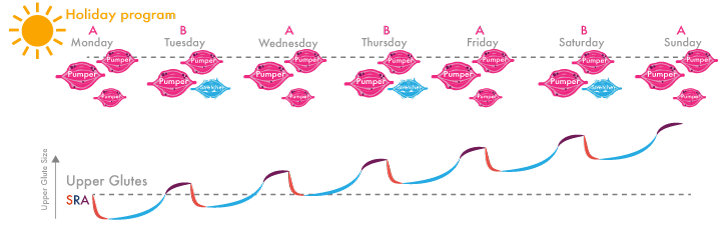 Want those Pumpers to have a bigger effect? Do a lot of Stretchers and Activators the weeks before you get on the plane. This way, the body will get very sensitive for the period of Pumpers to come (Ogasawara et al., 2013). This ties in nicely with the next example…
Want those Pumpers to have a bigger effect? Do a lot of Stretchers and Activators the weeks before you get on the plane. This way, the body will get very sensitive for the period of Pumpers to come (Ogasawara et al., 2013). This ties in nicely with the next example…Example 3: alternating high frequency and low frequency periods
Your body is an adaptive system. It gets used to a specific stimulus (such as training frequencies) over time (Ogasawara et al., 2013). That’s why alternating high-frequency periods with low frequency periods is a sensible idea.
For example, for 4 weeks you would train the Glutes 3 times per week. At the end of that period, the muscle protein synthesis after a workout will have dropped to a fraction of the initial amount. That’s the perfect time to start 4 weeks training the Glutes 6 times per week, then go back to a reduced frequency.
The key point here is that your exercise type (Activator, Stretcher, Pumper) SRA time should always match the time between workouts. In this case, pumper exercises are a great choice during the high frequency period. You would emphasize stretchers and activators for the low frequency weeks.
 Individual differences
Individual differences
Still, there are some people who just respond better to some type of exercise when it comes to Glute growth. You’ll have to find this out for yourself.
A way you could go about this is doing the alternating periods of high and low frequency. See which of those periods your Glutes respond better to. If they respond better to low frequency with Stretchers and Activators, you want to emphasize those types of exercises. For example, you could alternate 6 weeks of low frequency Stretchers/Activators with 2 week of high frequency Pumpers. This way, you spend most time doing the type of exercise and frequency you respond best to. The 2 weeks of high frequency training will resensitize your Glutes for a new 6-week block of Stretchers/Activators (Ogasawara et al., 2013). Of course, you’ll always be doing activators, stretchers, and pumpers, but the proportion of exercise type changes according to the training frequency.
Furthermore, Bret has observed that some people fire the Glutes a lot more during certain exercises than what you’d expect. For example, some individuals feel their glutes working harder during barbell hip thrusts compared to band hip thrusts and vice versa. Some individuals feel frog pumps a ton in their glutes, while others don’t at all and prefer wide stance dumbbell glute bridges for high reps. Some individuals feel the Romanian deadlift heavily working their glutes while others only feel this exercise in the hamstrings. Most individuals get very sore from walking lunges, but some get even more sore from hip thrusts, which is strange as it seems to defy physiology. It is your job through experimentation to discover what fires up your own Glutes the most, but training is a lifelong journey of learning so be patient and utilize the scientific method.
I left some stones unturned…
I want to close by saying this is not the whole story behind training frequency. Muscles aren’t the only tissues in the body that have an SRA curve. Nerve tissue, glycogen stores, and connective tissue also take time to recover and adapt, and this can’t be ignored. In the next article I’ll pay attention to these other body systems. I will also discuss the other factors in Glute SRA: Glute training experience.
However, now you should know how Glute exercise type impacts how often you should train for the fastest growth possible. What are you waiting for? Get going and bust your butt!
Final disclaimer
I’d like to point out that there are numerous researchers who hold muscle damage in a very high regard (Paulsen et al., 2012). They argue that eccentric-focused muscle-damaging exercises are the best at increasing the amount of muscle nuclei in the muscle fibers. Why is this important? Read on…
You could see these muscle nuclei as factories with muscle-repairing workers. These workers are to remain on stand-by to rebuild and build-bigger the muscle whenever another ‘tornado’ of exercise arrives (Bruusgaard et al., 2010). A single factory can only maintain a certain domain of muscle mass. In order for the muscle to grow even bigger, more factories have to be added. As said, the researchers think exercises that do the most muscle damage are best for this (Paulsen et al., 2012). Overall, you could say that more factories means more workers, which means more long-term capacity for muscle growth.
 Because of this, I wouldn’t advise the people who respond best to high-frequency training to do Pumpers year-round. That’s like keeping the amount of workers the same, but asking them to build and maintain even more muscle mass, without any time off. The workers will burn out.
Because of this, I wouldn’t advise the people who respond best to high-frequency training to do Pumpers year-round. That’s like keeping the amount of workers the same, but asking them to build and maintain even more muscle mass, without any time off. The workers will burn out.
Investing in more factories (with more workers) could possibly help this. Make sure there are times in the year where you really go all-out on damaging stretcher exercises. For example, you could focus on multiple heavy (or even eccentric-emphasized) sets of Bulgarian Split Squats, Full Squats, and off-bench Side Lying Hip Abductions for a few weeks at a time. The muscle damage they cause will likely increase the amount of worker factories (muscle nuclei) in the Glutes. In the long run, this possibly increases your Glutes’ capacity to increase their size.
The above reasons could possible explain why a lot of bodybuilding prefer training a muscle only once a week. They might need 50 sets in one session to damage the muscle enough for it to increase the amount of muscle nuclei further, in order to allow for further muscle growth. However, there are three reasons why this practice should be held with great skepticism. First, the recent meta-analysis on training frequency showed a clear hypertrophic advantage with training a muscle group twice per week as opposed to once per week. Second, anecdotally speaking, whenever a bodybuilder is trying to bring up a weak muscle, he or she increases the training frequency for that weak part. And third, metabolic stress exercise has been shown to activate just as much (if not more) satellite cells as damaging exercise (Nielsen et al. 2012), which is followed up by more muscle nuclei.
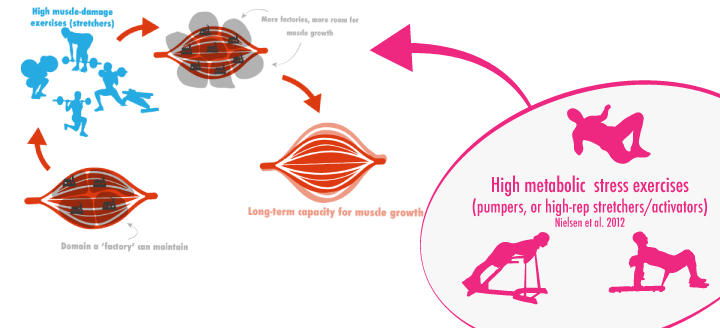 This plays a strong case for high frequency pumper workouts in comparison to low frequency stretcher workouts for the purpose of increasing muscle nuclei over the long-run. The good news is that you don’t have to choose one over the other; you can easily incorporate all 3 types of exercises into your training by following the advice I’ve included in this article.
This plays a strong case for high frequency pumper workouts in comparison to low frequency stretcher workouts for the purpose of increasing muscle nuclei over the long-run. The good news is that you don’t have to choose one over the other; you can easily incorporate all 3 types of exercises into your training by following the advice I’ve included in this article.References
- Alkner, B. A., Tesch, P. A., & Berg, H. E. (2000). Quadriceps EMG/force relationship in knee extension and leg press. Medicine & Science in Sports & Exercise, 32(2), 459–63.
- Brook, M. S., Wilkinson, D. J., Mitchell, W. K., Lund, J. N., Szewczyk, N. J., Greenhaff, P. L., … Atherton, P. J. (2015). Skeletal muscle hypertrophy adaptations predominate in the early stages of resistance exercise training, matching deuterium oxide-derived measures of muscle protein synthesis and mechanistic target of rapamycin complex 1 signaling. FASEB Journal, 29(11), 4485–4496.
- Bruusgaard, J. C., Johansen, I. B., Egner, I. M., Rana, Z. A., & Gundersen, K. (2010). Myonuclei acquired by overload exercise precede hypertrophy and are not lost on detraining. Proceedings of the National Academy of Sciences, 107(34), 15111-15116.
- Burd, N. A., Mitchell, C. J., Churchward-Venne, T. A., & Phillips, S. M. (2012). Bigger weights may not beget bigger muscles: evidence from acute muscle protein synthetic responses after resistance exercise. Applied physiology, nutrition, and metabolism, 37(3), 551-554.
- Caterisano, A., Moss, R. F., Pellinger, T. K., Woodruff, K., Lewis, V. C., Booth, W., & Khadra, T. (2002). The effect of back squat depth on the EMG activity of 4 superficial hip and thigh muscles. Journal of Strength and Conditioning Research / National Strength & Conditioning Association, 16(3), 428–432.
- Clarkson, P. M., Byrnes, W. C., McCormick, K. M., Turcotte, L. P., & White, J. S. (1986). Muscle soreness and serum creatine kinase activity following isometric, eccentric, and concentric exercise. International journal of sports medicine, 7(03), 152-155.
- Contreras B. (March 15 2010). Inside the muscles: Best Back and Biceps Exercises. Retrieved from: https://www.t-nation.com/training/inside-the-muscles-best-back-and-biceps-exercises
- Contreras, B., Vigotsky, A. D., Schoenfeld, B. J., Beardsley, C., & Cronin, J. (2015). A comparison of gluteus maximus, biceps femoris, and vastus lateralis electromyographic activity in the back squat and barbell hip thrust exercises. Journal of Applied Biomechanics, 31(6), 452–458.
- Damas, F., Phillips, S. M., Libardi, C. A., Vechin, F. C., Lixandrao, M. E., Jannig, P. R., … Urgrinowitsch, C. (2016). Resistance training-induced changes in integrated myofibrillar protein synthesis are related to hypertrophy only after attenuation of muscle damage. The Journal of Physiology, 0, 1–14.
- Dankel, S. J., Mattocks, K. T., Jessee, M. B., Buckner, S. L., Mouser, J. G., Counts, B. R., … Loenneke, J. P. (2016). Frequency: The Overlooked Resistance Training Variable for Inducing Muscle Hypertrophy? Sports Medicine.
- Franchi, M. V., Wilkinson, D. J., Quinlan, J. I., Mitchell, W. K., Lund, J. N., Williams, J. P., … Narici, M. V. (2015). Early structural remodeling and deuterium oxide-derived protein metabolic responses to eccentric and concentric loading in human skeletal muscle. Physiological Reports, 3(11), e12593–e12593.
- Gibala, M. J., MacDougall, J. D., Tarnopolsky, M. A., Stauber, W. T., & Elorriaga, A. (1995). Changes in human skeletal muscle ultrastructure and force production after acute resistance exercise. Journal of Applied Physiology, 78(2), 702-708.
- Gibala, M. J., Interisano, S. a, Tarnopolsky, M. a, Roy, B. D., MacDonald, J. R., Yarasheski, K. E., & MacDougall, J. D. (2000). Myofibrillar disruption following acute concentric and eccentric resistance exercise in strength-trained men. Canadian Journal of Physiology and Pharmacology, 78(September), 656–661.
- Hackett, D. A., Johnson, N. A., & Chow, C.-M. (2013). Training practices and ergogenic aids used by male bodybuilders. Journal of Strength and Conditioning Research / National Strength & Conditioning Association, 27(6), 1609–17.
- Lieber, R. L., & Fridén, J. (1993). Muscle damage is not a function of muscle force but active muscle strain. Journal of Applied Physiology (Bethesda, Md. : 1985), 74(2), 520–526.
- Loenneke, J. P., Thiebaud, R. S., Fahs, C. A., Rossow, L. M., Abe, T., & Bemben, M. G. (2013). Blood flow restriction does not result in prolonged decrements in torque. European Journal of Applied Physiology, 113(4), 923–931.
- McHugh, M. P., & Pasiakos, S. (2004). The role of exercising muscle length in the protective adaptation to a single bout of eccentric exercise. European Journal of Applied Physiology, 93(3), 286–293.
- McMahon, G. E., Morse, C. I., Burden, A., Winwood, K., & Onambélé, G. L. (2014). Impact of range of motion during ecologically valid resistance training protocols on muscle size, subcutaneous fat, and strength. Journal of Strength and Conditioning Research / National Strength & Conditioning Association, 28(April), 245–55.
- Miller, B. F., Olesen, J. L., Hansen, M., Døssing, S., Crameri, R. M., Welling, R. J., … Rennie, M. J. (2005). Coordinated collagen and muscle protein synthesis in human patella tendon and quadriceps muscle after exercise. J Physiol, 567(3), 1021–1033.
- Miller, S. C. (2014 Doctor’s Thesis). Mechanical factors affecting the estimation of tibialis anterior force using an EMG-driven modelling.
- Nielsen, J. L., Aagaard, P., Bech, R. D., Nygaard, T., Hvid, L. G., Wernbom, M., … & Frandsen, U. (2012). Proliferation of myogenic stem cells in human skeletal muscle in response to low‐load resistance training with blood flow restriction. The Journal of physiology, 590(17), 4351-4361.
- Nosaka, K., Newton, M., & Sacco, P. (2002). Delayed-onset muscle soreness does not reflect the magnitude of eccentric exercise-induced muscle damage. Scandinavian Journal of Medicine \& Science in Sports, 12(6), 337–346.
- Nosaka, K., Lavender, A., Newton, M., & Sacco, P. (2003). Muscle Damage in Resistance Training. International Journal of Sport and Health Science.
- Nosaka, K., Newton, M., Sacco, P., Chapman, D., & Lavender, A. (2005). Partial protection against muscle damage by eccentric actions at short muscle lengths. Medicine and Science in Sports and Exercise, 37(5), 746–753.
- Ogasawara, R., Kobayashi, K., Tsutaki, A., Lee, K., Abe, T., Fujita, S., … Kimball, S. (2013). mTOR signaling response to resistance exercise is altered by chronic resistance training and detraining in skeletal muscle. Journal of Applied Physiology (Bethesda, Md. : 1985), 114(7), 934–40.
- Paulsen, G., Mikkelsen, U. R., Raastad, T., & Peake, J. M. (2012). Leucocytes, cytokines and satellite cells: what role do they play in muscle damage and regeneration following eccentric exercise. Exerc Immunol Rev, 18(1), 42-97.
- Schoenfeld, B. J. (2010). The mechanisms of muscle hypertrophy and their application to resistance training. The Journal of Strength & Conditioning Research, 24(10), 2857-2872.
- Schoenfeld, B. J. (2013). Potential mechanisms for a role of metabolic stress in hypertrophic adaptations to resistance training. Sports Medicine, 43(3), 179–194.
- Schoenfeld, B. J., & Contreras, B. (2013). Is Postexercise Muscle Soreness a Valid Indicator of Muscular Adaptations?. Strength & Conditioning Journal, 35(5), 16-21.
- Schoenfeld, B. J., & Contreras, B. (2014). The muscle pump: potential mechanisms and applications for enhancing hypertrophic adaptations. Strength & Conditioning Journal, 36(3), 21-25.
- Schoenfeld, B.J., Ogborn, D., & Krieger, J.W. (2016). Effects of Resistance Training Frequency on Measures of Muscle Hypertrophy: A Systematic Review and Meta-Analysis. Sports Med, 46(11),1689-1697.
- Soares, S., Ferreira-Junior, J. B., Pereira, M. C., Cleto, V. A., Castanheira, R. P., Cadore, E. L., … & Bottaro, M. (2015). Dissociated Time Course of Muscle Damage Recovery Between Single-and Multi-Joint Exercises in Highly Resistance-Trained Men. The Journal of Strength & Conditioning Research, 29(9), 2594-2599.
- Thiebaud, R. S., Yasuda, T., Loenneke, J. P., & Abe, T. (2013). Effects of low-intensity concentric and eccentric exercise combined with blood flow restriction on indices of exercise-induced muscle damage. Interventional Medicine & Applied Science, 5(2), 53–59.
About The Author:

Stijn van Willigen has a bachelor’s degree in Human Movement Sciences and 8 years of experience in the world of weight training and nutrition. He specializes in science-based fitness for women, and tries to dispell myths on different themes with the science available. Presenting this in the form of engaging text and infographics are the main ways he hopes to accomplish this. A portfolio of his work can be viewed on his Instagram profile @fitfographs (www.instagram.com/fitfographs